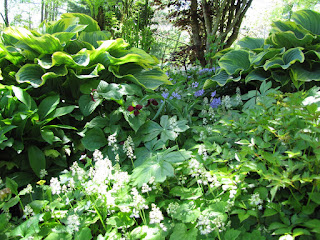If we can discover the meaning in the trilling of a frog, perhaps we may understand why it is for us not merely noise but a song of poetry and emotion.” Adrian Forsyth
Rana clamitans (green frog)
This little green frog is such a happy little creature. He watches proudly over the pond and the other green frogs that gather there. I suspect he samples an occasional tadpole as well as dining on insects. He is so bold that when I weed the flower bed at the edge of his little pond, he will sit in it, often only two feet from me. His eyes are constantly watching every move I make, but he does not hide. When my husband and I sit on our swing under the nearby pergola, he can hear us and often joins in the conversation. His banjo-like sound "c'tung" gets louder if we talk louder. I often wonder what he is trying to tell us.
A green frog peeks out from the leaves of a water lily. A perfect example of nature's camouflage.
Another good example of amphibian camouflage is this American Toad whose pictures were taken by my daughter while we were hiking on a trail in the Canaan Valley Refuge.
 I can tell he is an American Toad and not a Fowler's Toad because he only has 1-2 warts per spot. Fowler's Toads have 3-4 warts on each spot. An interesting thing about toads is that when they lay their eggs in the water, the egg masses are long, spiraling strings of several thousand black eggs.
I can tell he is an American Toad and not a Fowler's Toad because he only has 1-2 warts per spot. Fowler's Toads have 3-4 warts on each spot. An interesting thing about toads is that when they lay their eggs in the water, the egg masses are long, spiraling strings of several thousand black eggs.
This particular toad sat happily on the edge of our pond, sunning himself for many days. At night we were treated to the loud trill of his song.
On another of our hikes, we came across a spring peeper. This is the frog that most people associate with the beginning of spring. It is hard to believe that this creature with a very loud call is actually only 3/4" to 1 3/8" in size. The males call from shrubs or trees that stand in or overhang water. In winter, they hibernate under logs or in loose bark.
Finally, my favorite frog of all is the wood frog. It is truly the first frog of spring. They will make their way to an ephemeral pond, one that dries up in the summer, the first day after the snow has melted away. They make their presence known as they make loud quacking sounds like a duck. These are the frogs with bandit faces because they have a dark stripe below the eye. This is one that I pictured in an earlier post and it's egg mass.
This is my favorite frog picture, that of a very tiny baby wood frog, called a froglet, sitting on a lily pad.




+crop)








